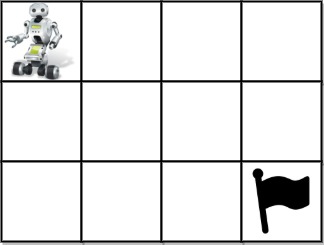- {x}
- Equal Rational Numbers
- K Closest Points to Origin
- Subarray Sums Divisible by K
- Odd Even Jump
- Largest Perimeter Triangle
- Squares of a Sorted Array
- Longest Turbulent Subarray
- Distribute Coins in Binary Tree
- Unique Paths III
- Time Based Key-Value Store
- Triples with Bitwise AND Equal To Zero
- Minimum Cost For Tickets
- String Without AAA or BBB
- Sum of Even Numbers After Queries
- Interval List Intersections
- Vertical Order Traversal of a Binary Tree
- Smallest String Starting From Leaf
- Read More...

Unique Paths III
You are given an m x n integer array grid where grid[i][j] could be:
1representing the starting square. There is exactly one starting square.2representing the ending square. There is exactly one ending square.0representing empty squares we can walk over.-1representing obstacles that we cannot walk over.
Return the number of 4-directional walks from the starting square to the ending square, that walk over every non-obstacle square exactly once.
Example 1:

Input: grid = [[1,0,0,0],[0,0,0,0],[0,0,2,-1]] Output: 2 Explanation: We have the following two paths: 1. (0,0),(0,1),(0,2),(0,3),(1,3),(1,2),(1,1),(1,0),(2,0),(2,1),(2,2) 2. (0,0),(1,0),(2,0),(2,1),(1,1),(0,1),(0,2),(0,3),(1,3),(1,2),(2,2)
Example 2:

Input: grid = [[1,0,0,0],[0,0,0,0],[0,0,0,2]] Output: 4 Explanation: We have the following four paths: 1. (0,0),(0,1),(0,2),(0,3),(1,3),(1,2),(1,1),(1,0),(2,0),(2,1),(2,2),(2,3) 2. (0,0),(0,1),(1,1),(1,0),(2,0),(2,1),(2,2),(1,2),(0,2),(0,3),(1,3),(2,3) 3. (0,0),(1,0),(2,0),(2,1),(2,2),(1,2),(1,1),(0,1),(0,2),(0,3),(1,3),(2,3) 4. (0,0),(1,0),(2,0),(2,1),(1,1),(0,1),(0,2),(0,3),(1,3),(1,2),(2,2),(2,3)
Example 3:

Input: grid = [[0,1],[2,0]] Output: 0 Explanation: There is no path that walks over every empty square exactly once. Note that the starting and ending square can be anywhere in the grid.
Constraints:
m == grid.lengthn == grid[i].length1 <= m, n <= 201 <= m * n <= 20-1 <= grid[i][j] <= 2- There is exactly one starting cell and one ending cell.
980. Unique Paths III
Problem Description
Given an m x n integer array grid representing a grid where:
1represents the starting square.2represents the ending square.0represents empty squares.-1represents obstacles.
Find the number of 4-directional walks from the starting square to the ending square that walk over every non-obstacle square exactly once.
Solution: Backtracking
This problem can be efficiently solved using a backtracking algorithm. The core idea is to explore all possible paths from the starting point to the ending point, keeping track of visited cells. We only consider valid paths that visit every non-obstacle cell exactly once.
Algorithm
-
Initialization:
- Find the starting coordinates (
start_row,start_col) and the ending coordinates. - Count the number of empty cells (
empty_count). This helps us determine if a path is complete.
- Find the starting coordinates (
-
Backtracking Function (
dfs):dfs(row, col, visited_count): This recursive function takes the current row and column, and the number of visited cells as input.- Base Cases:
- If we reach the ending square (
grid[row][col] == 2):- If
visited_countequalsempty_count + 1(all empty cells and the start cell have been visited), we found a valid path, so return 1. - Otherwise, return 0 (incomplete path).
- If
- If we reach the ending square (
- Recursive Step:
- Iterate over the four neighboring cells (up, down, left, right).
- For each neighbor:
- Check if it's within bounds, not an obstacle (
grid[neighbor_row][neighbor_col] != -1), and not already visited. - Mark the neighbor as visited.
- Recursively call
dfson the neighbor. - Unmark the neighbor (backtracking step). This allows exploration of other paths.
- Check if it's within bounds, not an obstacle (
- Return the sum of valid paths found from all neighbors.
-
Main Function:
- Call the
dfsfunction starting from thestart_row,start_col, and an initialvisited_countof 0.
- Call the
Time and Space Complexity
- Time Complexity: O(4N), where N is the number of empty cells. In the worst case, we explore all possible paths. The actual runtime is significantly smaller than this theoretical bound for most inputs because of early pruning with the
visited_countcheck. - Space Complexity: O(N) due to the recursive call stack and the
visitedset (or similar data structure to track visited cells).
Code (Python)
def uniquePathsIII(grid):
rows, cols = len(grid), len(grid[0])
start_row, start_col = -1, -1
empty_count = 0
for r in range(rows):
for c in range(cols):
if grid[r][c] == 1:
start_row, start_col = r, c
elif grid[r][c] == 0:
empty_count += 1
def dfs(row, col, visited_count):
if grid[row][col] == 2:
return 1 if visited_count == empty_count + 1 else 0
count = 0
for dr, dc in [(0, 1), (0, -1), (1, 0), (-1, 0)]:
new_row, new_col = row + dr, col + dc
if 0 <= new_row < rows and 0 <= new_col < cols and grid[new_row][new_col] != -1:
temp = grid[new_row][new_col]
grid[new_row][new_col] = -1 # Mark as visited (temporarily)
count += dfs(new_row, new_col, visited_count + 1)
grid[new_row][new_col] = temp # Backtrack
return count
return dfs(start_row, start_col, 0)
The code in other languages (Java, C++, Go, TypeScript, JavaScript) follows a very similar structure, using the same backtracking approach. The primary difference lies in syntax and data structure choices. The core logic remains consistent.